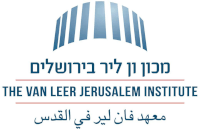In this brief essay I wish to focus on the cultural and identity-related aspect of the formula “partnership-based peace.” This aspect may also be called “the ours question,” in other words, the question of what is the common element available to all the people of this land, Palestinians and Jewish-Israelis alike. I will attempt to give a preliminary answer to this question, by way of an analytical and terminological discussion of the notion of identity and the ways in which it can be created or constructed in the case at hand.
In a seminal paper, Brubaker and Cooper propose a framework for a comprehensive critique of the use of the term “identity”1Rogers Brubaker and Frederick Cooper, “Beyond Identity,” Theory and Society 29, 1 (2000): 1-47.. According to them, “identity” serves to both to designate powerful senses of identification that involve emotional aspects and to designate weak senses of identification that do not involve such aspects. They contend that identity in the weak sense should be understood as a sense of commonality, that is, the feeling that one has something in common with another person; and also as a sense of connectedness, which expresses the fact that we are each grounded in a web of interpersonal relations that connects us to others. In this respect, commonality and connectedness express an affiliative understanding of oneself that is not comparable to the feeling of belonging to a group. It is a looser, less emotional feeling than the understanding of oneself as part of a group. Commonality and connectedness, separately and even taken together, do not amount to the feeling of “groupness,” which is the feeling of belonging to a distinct, bounded solidary group. At the same time, they do have the power to provide a sense of belonging that is not emotional to a broader identity category that does not compete with or undermine the identity category anchored in the various players in the field.
In the context of conflicts between culture groups – ethnic, national, or colonial – reconciliation as a recognition of a common fate, accepting the fact of mutual dependence, a shared geographical image, and identity as a daily, dialogical interaction are all ideas that can be understood as manifestations of commonality and connectedness. For example, James Hughes argues that in the case of Norther Ireland, resolving the conflict was based not a cultural transformation but on what he calls “a functional imperative.”2James Hughes, “Reconstruction without Reconciliation: Is Northern Ireland a Model?,” in Bill Kissane (ed.), After Civil War: Division, Reconstruction, and Reconciliation in Contemporary Europe (Philadelphia: University of Pennsylvania Press, 2014), 245-272. Similarly, Du Toit writes that the reconciliation in South Africa was based on a cognitive social acknowledgement of the interdependence of the conflicted groups.3Fanie Du Toit, When Political Transitions Work: Reconciliation as Interdependence (New York: Oxford University Press, 2018).
Shared geographical image as a manifestation is an example of a soft identity in the sense of commonality and connectedness and can be found in the writings on the modes of national identification of Scottish British citizens. For example, Sindic shows that the identification of some Scots as “of the island” replaces for them the identification as Britsh, and serves to justify the common framework and their belonging to it.4Denis Sindic, “Psychological Citizenship and National Identity,” Journal of Community & Applied Social Psychology 21, 3 (2011): 202-214. Of course, that is not to say that this is the only justification, since considerations of political equity and economic advantageousness are most likely also taken into account. Sindic proposes to construct a community by emphasizing the commonality of the geographical image and cultivating it; in the above example – cultivating the image of “islanders.” This approach is essentially different from the construction of a community based on a discursive representation of the group members as having similar characteristics, like language, religion, ethnicity, etc. Based on a critique of the way in which the notion of identity is understood in the social identity theory associated with Tajfel, Condor also proposes the construction of a political community based on a relation to space rather than to the Other.5Henri Tajfel, “Social Psychology of Intergroup Relations,” Annual Review of Psychology 33, 1 (1982): 1-39; Susan Condor, “Pride and Prejudice: Identity Management in English People’s Talk About this Country,” Discourse & Society 11, 2 (2000): 175-205.
Commonality and connectedness as manifestations of a dialogical micro-interaction, and not as shared cultural materials, which typically characterize a strong identification, underlie both the model of a shared citizenship and the model of urban citizenship. Researchers propose the model of a shared citizenship as an alternative to the melting-pot model as well as to the model of the hyphenated identities (known also as the “plus” model), arguing that the latter two are ill-suited to cases in which the conflict has colonial dimensions.6Marc Woons, “Decolonizing Canadian Citizenship: Shared Belonging, Not Shared Identity,” Settler Colonial Studies 4, 2 (2014): 192-208. It is important to note that even though these examples concern the construction of commonality and connectedness within the framework of citizenship, they are equally valid beyond this framework – as in the case of a confederative framework.
Assuming that it is preferable to regard soft identity as a step on the way to the creation of a strong identity, the question arises: Under what conditions, if any, might the recognition of commonality or connectedness create groupness? Brubaker and Cooper contend that in order for commonality and connectedness to be able to create a sense of groupness, they need to be accompanied by a sense of belonging to each other – what is sometimes described as horizontal belonging. The sense of belonging required to create groupness has to do with the objective level of the commonality and connectedness: the higher the level of the commonality and connectedness – whether it is institutional, material, or cognitive – the greater the chance of creating a sense of horizontal belonging. Brubaker and Cooper argue that the more that commonality and connectedness are encoded into the narratives, meta-narratives, or discursive framework and cultural repertoire available to the parties, the greater the chance that commonality and connectedness will also produce a sense of groupness. Entrepreneurs or cultural agents should read this claim as an invitation to propose frameworks of meaning that will encourage recognition of the commonality and the connectedness and an acceptance of them, in order to cultivate a supra-national, supra-state political community.
Of course, these brief words of mine are no more than preliminary analytical notes. Further developing the analytical and terminological outline proposed here may provide theoretical, explanatory and transformative tools that will enable a distinction between the question “What do we have that makes us alike?” and “What do we have in common?”; or a distinction between “people like us” and “people with whom we have something in common.” These tools are offered as part of the attempt to identify, understand, explain or create a supra-categorical resemblance based on affinity to a particular space – like a shared homeland; or based on relation to a certain predicament – like interdependence in its various manifestations. The use of these tools must be such that it does not negate the national-emotional category that is operative in the field, and does not ignore it. It is manifestations of a soft identity, i.e., of commonality and connectedness, that stand to justify supra-national and supra-state identity structures and to protect them. These structures are crucial for the shaping of a supra-state framework for Israel/Palestine, and moreover – for ensuring its long-term stability.
- 1Rogers Brubaker and Frederick Cooper, “Beyond Identity,” Theory and Society 29, 1 (2000): 1-47.
- 2James Hughes, “Reconstruction without Reconciliation: Is Northern Ireland a Model?,” in Bill Kissane (ed.), After Civil War: Division, Reconstruction, and Reconciliation in Contemporary Europe (Philadelphia: University of Pennsylvania Press, 2014), 245-272.
- 3Fanie Du Toit, When Political Transitions Work: Reconciliation as Interdependence (New York: Oxford University Press, 2018).
- 4Denis Sindic, “Psychological Citizenship and National Identity,” Journal of Community & Applied Social Psychology 21, 3 (2011): 202-214.
- 5Henri Tajfel, “Social Psychology of Intergroup Relations,” Annual Review of Psychology 33, 1 (1982): 1-39; Susan Condor, “Pride and Prejudice: Identity Management in English People’s Talk About this Country,” Discourse & Society 11, 2 (2000): 175-205.
- 6Marc Woons, “Decolonizing Canadian Citizenship: Shared Belonging, Not Shared Identity,” Settler Colonial Studies 4, 2 (2014): 192-208.

















